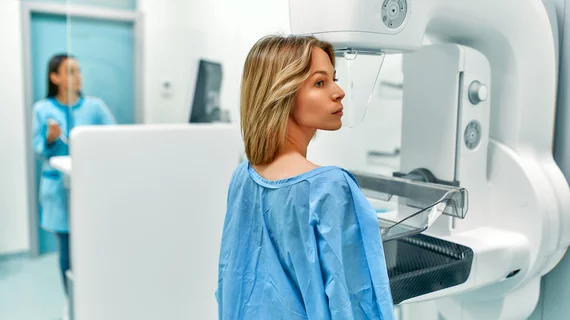Mammography guideline changes have produced a ‘harmful’ spillover effect
Changes to mammography guidelines may have produced a “harmful” spillover effect, according to a new analysis published Wednesday.
Back in 2009, the U.S. Preventive Services Task Force revised recommendations for regular breast imaging, upping the age from 40 and up to, instead, 50 to 74. The update was controversial at the time, with new guidelines contradicting advice offered by other professional societies.
Experts have theorized that this change could have produced a spillover effect on patients outside of the stated range, dragging down rates among all populations. That hypothesis has proven to be true, according to a study published in the American Journal of Preventive Medicine [1].
Prior to 2009, national screening trends had remained flat among women in their 40s, ages 50 to 74, and older than that second range. However, after the USPSTF guidelines were released, screening rates fell 1.3 percentage points among women 40 to 49 and 1.7 percentage points for those 75 and up. Meanwhile, women 50 to 74 also saw a 0.47 percentage-point decline, but the change was not deemed statistically significant.
“The findings are consistent with a harmful spillover effect,” Sarah A. Nowak, PhD, with the Department of Pathology and Laboratory Medicine, Larner College of Medicine, at the University of Vermont, and co-authors wrote Feb. 22. “Breast cancer screening rates are already suboptimal in women aged 50-74 years, and further declines in screening could result in delayed diagnosis and increased breast cancer mortality.”
Nowak et al. conducted their study using national data from the Centers for Disease Control and Prevention's Behavioral Risk Factor Surveillance System, spanning 2002 to 2018. They also analyzed state-level variation in screening rate changes following 2009, determining the magnitude of spillover effect on each targeted group.
Screening rates showed declines across 47 different states and the District of Columbia for women 40-49 at an average of -1.2 percentage points per year. Women 75 and up also saw screening rates drop across all states—though only in a statically significant manner in 27—at an average of -0.5. And even the USPSTF-targeted range saw declines across 45 states and D.C. at an average of -0.5.
“States most successful at reducing mammography screening rates in populations where routine screening is no longer recommended also saw reductions in recommended screenings,” the authors concluded. “More work is needed to understand and mitigate unintended consequences of de-implementation and to understand whether unintended consequences have differential effects on different populations.”
Nowak and co-authors speculated that the drops could be attributed to other factors, such as media reports on guidelines changes producing a “decreased perceived benefit of screening.” It’s also possible the trends would have occurred without the revised guidelines, owing to factors such as policy changes associated with the Affordable Care Act, they wrote.

